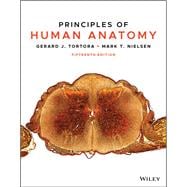Immerse yourself in the spectacular visuals and dynamic content of Principles of Human Anatomy. Designed for the one-term Human Anatomy course, this textbook raises the standard for excellence in the discipline with its enhanced illustration program, refined narrative, and dynamic resources. Principles of Human Anatomy is a rich digital experience, giving students the ability to learn and explore human anatomy both inside and outside of the classroom.








